Marcel van Marrewijk's Blog, page 93
January 18, 2018
Adobe has opened its Creative Residency Applications
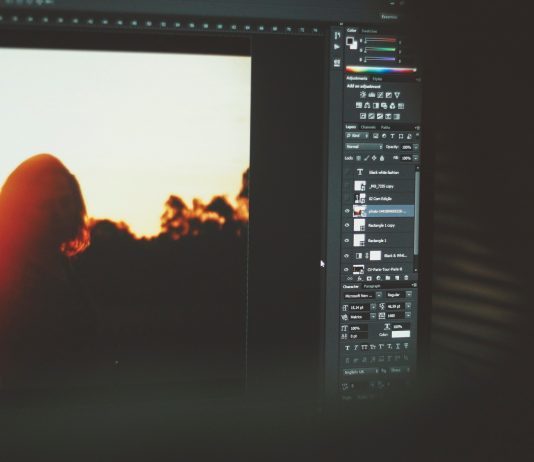
Every year Adobe hosts its Creative Residency, inviting artists from the United States, Canada, United Kingdom and Germany to apply for a one-year residency. No, that does not mean that the artists have to relocate. While you can stay living in your own house, Adobe does support the residents financially to travel during 25% of the time they are making the residence. Residents can travel to events hosted by Adobe such as Creative Jams and Adobe MAX.
The residents will also get a full salary for the whole year they are participating in the program. The goal is that they can work in an authorial project, which in the end, will be owned solely by the resident itself. This year Adobe is looking for creative minds working on UX/UI Design, Photography, Digital Drawing and Painting, Graphic Design and Online Video.
Beyond the financial support, Adobe also offers a mentorship, all the Adobe package (of course) to all residents plus all the necessary hardware. For that Adobe created an application asking its possible residents to answer about their project, how they intend to contribute to the creative community and what does it teach other creative minds. You will also need to declare which tools you are using and what is your budget (excluding your salary, living expenses, and travel costs).
Are you curious? Well, even if you are not an eligible creative mind for the residency you can follow up with the current residents in the Adobe online magazine, as they tell a bit about themselves, their project and also give some very valuable tips! By the way, that’s the only thing that Adobe asks in return; for the residents to share their stories and progress with the creative community. Be that by writing blogs, on their own social media or speaking on events. This could also mean they are doing it for social capital, very much like in Seats2meet.
And what if you are an eligible person for the Creative Residency? Well, you can click here and see how to apply. Also, notice that Adobe shared a blog on how to shine in your application. Good luck and may the force be with you!
The post Adobe has opened its Creative Residency Applications appeared first on Seats2meet.
Ants on a Shrimp – Failing towards greatness
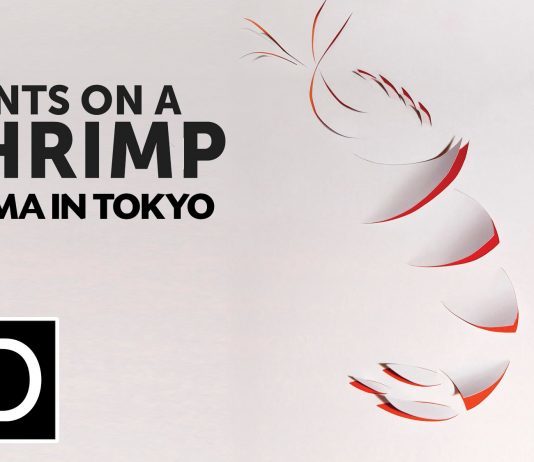
You may have or may not have heard about a documentary called Ants on a Shrimp. I hadn’t until two days ago when my mother in law mentioned it. The film is about Noma, a Danish restaurant that has been on the list of 50 best restaurants in the world since 2007 and topping the list for four years. The documentary takes time January of 2015 when the restaurant relocated its entire staff to Tokyo for five weeks.
Ok, and why am I talking about this documentary? It really stuck with me the period before the restaurant opened. Especially when René Redzepi sends his four cooks Rosio Sanchez, Thomas Frebel, Lars Williams and Kim Makkala to prepare the menu. It’s funny how when we live our day to day lives we often take for granted the effort put by someone for the simplest of things. And for me, that happens a lot with restaurants. I mean, I go into a restaurant, I order, and I eat. But watching all the effort put behind that takes you on a ride.
The four creative minds go on a ride working 20 hours per day for a month to create the perfect menu. And it’s all crashed on René arrives. The chef questions and deconstruct it all. And then it comes the scene when one of them says “Our work is 99% failure”. In a way that they do know that to achieve the greatness of being the best restaurant in the world ego is put aside. What comes in instead of it is the recognition that things can be better. They always can. And although it can be hard to watch, it can also give lots of insights. At least that’s what it gave me.
So if you feel like getting inspired by the creative process of those geniuses, you can watch it on Amazon. And I would advise you to watch with your belly full because boy you are going to be hungry.
The post Ants on a Shrimp – Failing towards greatness appeared first on Seats2meet.
January 17, 2018
Seats2meet.com Utrecht CS zoekt nieuwe Keukentopper
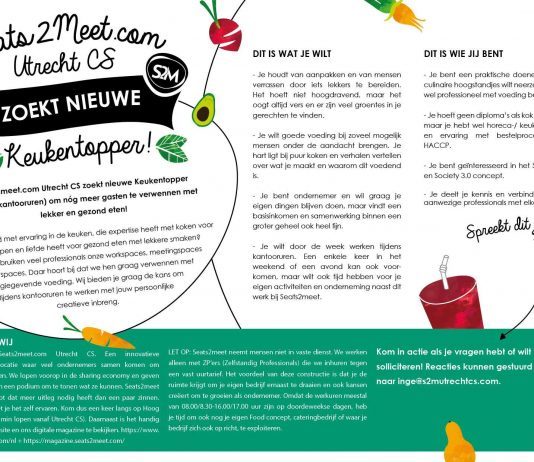
Apply sending an e-mail to inge@s2mutrechtcs.com
The post Seats2meet.com Utrecht CS zoekt nieuwe Keukentopper appeared first on Seats2meet.
BiD Network is looking for a COO

Opportunity via BiD Network
BiD Network is an independent trusted partner for SME’s in East Africa by facilitating tailored financial solutions throughout their life cycle. We currently have a small team of 7 people with offices in Kampala and Amsterdam. In 2018 we will also start operations in Rwanda. Our customers are early stage and growing businesses with a financing need of at least USD 50,000.
Since 2007, BiD Network has raised over 33 million in investment capital for over 230 entrepreneurs. Via its local office in Uganda, BiD Network offers investment readiness and dealmaking services to selected entrepreneurs that have at least 100.000 USD revenue, social impact, significant growth potential and a competent entrepreneurial team. Via these services, BiD Network is able to provide high quality deal flow to its large international network of investors, both private and institutional.
In the next few years, we are planning to expand our office network into the East African region and finalise our transition from an NGO to a company. In this context, we are looking for a:
COO
Besides daily operations, you will be responsible for building a solid scalable and replicable model that is needed for our ambitious international expansion plans. Primary goal is digitise (parts of) our primary process and develop a blueprint for international scaling. You will be working closely with staff from all offices to secure development and implementation of the blueprint and create an atmosphere in which the whole team is continuously trying to learn and improve.
Concrete responsibilities include, but are not limited to:
Play a key role in continuously optimising and professionalising the organisation
Guidance and supervision of staff on building a winning global team.
Implement standardised and digitized procedures.
Lead the digitization of (parts of) primary process.
Create a comprehensive blueprint (handbook) for scaling up BiD operations geographically.
Financial management and reporting
Ensure that BiD Network complies to rules and regulations.
We are looking for a candidate that matches the following profile:
a communicative person who does not mind making the hands dirty while growing an organisation
Minimum 5-8 years of relevant international experience in operational excellence and upscaling.
Expertise in development and implementation of continuous learning & improvement within a small organisation operating in a quickly changing international environment.
Track record in leading digitization processes and affinity with fintech.
Previous experience with impact investing and working in Africa is a pre.
Academic degree.
Very accurate, analytical, structured and persistent.
Pragmatic; flexible, self-starter and proactive.
Entrepreneurial and commercial attitude.
Culturally sensitive
Open to travel regularly.
Organizational structure
BiD Network is a small organization, with offices in Amsterdam and Kampala and people from different backgrounds. The Amsterdam office is mostly concerned with overall management and strategy, business development, financial reporting and scaling up. As COO you will be based in the Amsterdam office, but work closely together with the teams in Africa, and report directly to the Director.
What do we offer
MT member & potential co-founder.
Strong complementary team with Director.
Dynamic and international working environment.
Small ambitious team, allowing for personal growth and much responsibility/ accountability.
Get in-depth understanding of doing business in East Africa.
Salary based on qualification and experience (max EUR 65.000 gross salary, incl benefits).
Single package (no schooling, no relocation costs).
The post BiD Network is looking for a COO appeared first on Seats2meet.
Expert Selection: Changing Relations With Things Through The Internet Of Things
 Iskander Smit
Iskander SmitIskander Smit is the Innovation Director at Info.nl, an Amsterdam agency which designs connected digital products and services. He is responsible for the research and development and he manages labs.info.nl. Iskander has a background in Industrial Design Engineering and has been working as a creative and strategist in digital services. He has a proven track record for designing and thinking on the Internet of Things. As of 2009 Iskander is a member of the Internet of Things Council and in 2013 he co-founded the Bahavior Design AMS meetup. In December 2014 he initiated and co-organized the (now annual) Amsterdam edition of the Berlin conference Thingscon, a leading conference on the design of the Internet of Things that aims to foster the creation of a responsible and human-centric Internet of Things. In April 2017 Iskander started working as a visiting professor at the Connected Everyday Lab at the TU Delft University of Industrial Design Engineering. Here he will be setting up a new research program that will study the impact of things as citizens in our intelligent cities.
“Connected things are entering our lives more and more, becoming the default. We will get used to new functions in existing products and new type of things will be introduced in our lives. Things that adapt to the context of use, where we will have conversations with each other via other interfaces than the screen and things will be a platform for related services. It will be interesting how our relation with things will change.”
http://www.tis.tv/video/project-jacqu...
“Google has been researching new interactions for some years in their ATAP lab, such as project Jacquard. One of their first market ready products is a collaboration with Levi’s, known for their denim jeans, to create a tech commuter jacket made of conductive fabrics. New fabrics will become more common is the general belief. Functions will change and become disconnected from the digital form. But more interesting is how this is a signpost for the merge of digital and connectedness in everyday products without being a connected product. I’m looking forward to seeing products like these that go beyond the low-hanging fruit of just connecting with your phone.”
http://www.tis.tv/video/synthetic-sen...
“The Future Interfaces Group of Carnegie Mellon University shows what the possibilities are when sensors are combined with super smart software; and become a super sensor. This will lower the possibilities of connecting daily behavior to the digital. No surprise Google has adopted this research project. I don’t think this product will enter our market any time soon, but we shouldn’t keep our eyes closed to the fact that many household appliances are already equipped with sensors.”
http://www.tis.tv/video/affective-thi...
“Here’s a possible scenario of what might happen when things become more intelligent, become autonomous agents themselves. These so-called ‘affective things’ are depicted in this clip going by the same name. It’s based on a design research project by Iohanna Nicenboim and Elise Giaccardi of the TU Delft, whom I know through my work at the university and Thingscon. The project which is a collaboration with The Incredible Machine is speculative, but the notion that things will be able to communicate autonomously among each other isn’t that far off from becoming reality. It has started with the phone, but more things are sure to follow, think of services like IFTTT (if this, then that) and Triggi.”
http://www.tis.tv/video/uninvited-guests
“How we relate to the things that become more intelligent is very well sketched in this a bit older movie ‘Uninvited guests’. It stresses how important the human factor is in developing the connected things.”
http://www.tis.tv/video/emily-gorcens...
“The importance of ethics in the Internet of Things is well-presented by Emily Gorcenski. She is making a true statement on the responsibility of the tech makers to keep validating the limits of the impact of their work. That is important with software development in general but even more with software development in the IoT space where consequences often much more impact in real-life.”
http://www.tis.tv/video/cities-for-to...
“IoT is strongly related to the changing cities we live in where things become more and more autonomous in their behavior. I’m involved with this interesting Amsterdam project called ‘Roboats’, which is currently being developed by a collaboration between MIT and TU Delft. Roboats are autonomous boats that possibly form the new infrastructure of this increasingly crowded city. The way it’s implemented, as part of the city, will positively influence the acceptance of the city’s inhabitants. If you ask me, that’s a more realistic approach than autonomous flying drones.”
http://www.tis.tv/video/alasdair-alla...
“Security is one of the important topics in IoT. That’s not just about making the things unhackable, but also about creating a sense of trust for consumers, who are ultimately letting these connected products into their homes. Some great initiatives, such as IoT Mark are now building a trustmark that can be adopted by the industry, the makers of IoT products. In this presentation ‘The Little Things of Horror’, Alasdair Allan gives some good examples on how IoT products are doing it wrong.”
The post Expert Selection: Changing Relations With Things Through The Internet Of Things appeared first on Seats2meet.
January 5, 2018
Crash and burn: this is what I learned from my failed crowdfunding campaign.
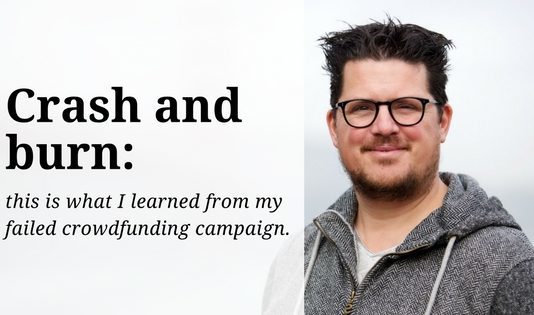
‘It’s allowed to make mistakes’ is a lofty phrase used by many managers and business leaders, but in practice there are only a few stories to read about the lessons learned from failures. What a waste it is; therefore, I’m willing to discuss and share mine with the associated lessons I’ve learned.
I’ll be talking about crowdfunding. In 2011, I have been the first person in the world to finish a share-based crowdfunding campaign. 171 investors accumulated 20.000 euro for translating, designing, and printing of the English version of my book, Brand Expedition: A Journey Visiting Europe’s Most Inspiring Brands, within 10 weeks. A book as a business with the ambition to be marketed as an international bestseller. Now, more than 5 years on, the project of the English book has been discontinued officially. The enormous ambitions and the boundless energy haven’t resulted in the desired results, and both the investors and I are left empty handed. In this article, I’ll look back on the crowdfunding adventure and share my ‘lessons learned’.
Crowdfunding lesson 1: Why people invest?
This book campaign was marked by the choice for crowdfunding with shares through the Symbid platform. First of all, this hasn’t been a strategic choice, but one that came by happenstance. I know someone involved in Symbid and he convinced me of the idea to crowdfund. To me, an interesting chance to realize my ambitions for an international bestseller and a great success case for Symbid. The book and the story of my journey were quite well-known (150+ publications in all imaginable media).
In hindsight, one may ask if the choice for crowdfunding with shares had been the best option. The question I should have asked myself is: Why would people invest in my dream, and help me realize an English version of my book, which was successful in The Netherlands?
Of course, I posed the question to quite a few investors. What turned out is that the broad majority took part because they fancied the idea or they were in for their own benefit in a signed copy of the book, an consulting session, or a presentation. The expectation of ‘an overwhelming profit’ wasn’t mentioned by anyone. Not so surprising in itself as the value of the book will only decrease over time; and, with an average investment of about 50 euro, it wouldn’t have made anyone rich.
If most investors weren’t in it for the profit, the choice of crowdfunding with shares, being wise after the event, hasn’t been the right choice. Maybe I would have accumulated a couple thousand euro less, but for the choice of a shares campaign I had to pull up Book BV, a private limited liability company, and Book Cooperative UA, an official cooperative, and my sole proprietorship had to be turned into a private limited liability company forcefully. This just because the 80% of the remaining shares for me, with a paper value of 80,000 euro, were perceived as profit by the tax authority. I was almost forced to pay tax over this amount. Without this construction, only half of the money would have been sufficient.
Crowdfunding lesson 2: The valuation?
Coming up with a decent valuation of a non-existing company is a troublesome task. In my case, I sold 20% of the shares in Book BV for 20,000 euro, which implied a valuation of my book of 100,000 euro. Despite the great ambitions we had for the book, one may say that the valuation was still quite sassy for a book of an obscure author, regardless of his reputation within the Netherlands. And by the way, he had decided to publish the book independently and solely sell it on the internet.
CONTEXT : At the valuation of the book, we presumed an ambitious, and in retrospect vulnerable, scenario in which the book would become an international bestseller. Nowadays, there are crowdfunding variants on the market in which the valuation is postponed, a so-called ‘convertible loan’. One raises funds from the crowd in exchange for a loan with an x interest rate. At the time the next bigger investor joins, the previous investor will be offered the opportunity to convert the the loan into a share. The initiative has usually lasted for some more months or years by which the valuation can be based on far more information. Moreover, the mostly young and inexperienced crowd benefits from the knowledge and negotiation power of this investor.
Crowdfunding lesson 3: Choose the right funding target.
I had chosen a funding target of 20,000 euro for my campaign. This amount was reserved for the translation (5,000), the design (2,000), the print of the book (10,000), and the establishment of both the private limited liability company and the cooperative (5,000). Besides, 20,000 euro was also the minimum amount to crowdfund at Symbid, partially based on the fact that 18,000 euro was needed to establish a private limited liability company.
20,000 euro was actually to little, as the sum of the costs mentioned above already accounts for 22,000 euro. In addition, I needed an office, ICT infrastructure, diverse subscriptions, and I had to put bread on the table for myself. I, furthermore, employed a complete team of interns and volunteers, incurring considerable costs.
In order to give the project a chance, I invested over a year of my time (excluding the time for preparations and the campaign) and bore many of the cost personally.
I could have chosen a cheaper solution or should have raised more money. The assumption that additional cost would sufficiently be covered by book sales coming into swing, was, looking back, a risk I should have arranged for with a bigger margin.
Crowdfunding lesson 4: Does your crowd match the audience of your project?
Although the audience of my English book would not be in the same country, the overwhelming majority of my investors lived in the Netherlands. Of course it was logical to raise money among the Dutch as my network and reputation were mainly directed to the Netherlands, but it made it much harder to set the stage outside of my home country.
Realistically I think that It wouldn’t have been possible to crowdfund the project fully outside of the Netherlands, for my reputation and network weren’t sufficiently established there. Next time, I will be looking for a better mix between the two.
Crowdfunding lesson 5: Community management is an art in itself.
Crowdfunding sounds fancy: you’re obtaining, besides the ‘funding’, also an involved ‘crowd’ with your campaign. In my case 171 investors. But at the time you’re busy establishing your company or project, it will be hard to keep that audience involved. I have invested in several hundreds of crowdfunding projects to see how others deal with this. Conclusion: the number of project owners communicating well with their supporters can be counted on the fingers of one hand.
Reflecting on my whereabouts, I’ve send an update to my investors about the progress with a certain regularity. I also made an analysis of the several areas in which the investors are actively involved and which of these could be beneficial in finding answers on certain questions. But as the ambition to market a translation slowly showed less and less feasible, my contact with my investors worsened rapidly.
This is my main lesson: Plan ahead for ways to involve the crowd and devote time to it. Also when you’ve got the feeling things won’t work out as planned. Perhaps, even more so in such cases.
In the end, Book BV and the Book Cooperative UA have existed for five years, although it was clear that the project would not meet the ambitions we used to have. The reason? I didn’t want to admit things had failed to work out. I also dreaded the administrative hassle[4] associated with the termination of the private limited liability company and the cooperative, which wasn’t necessary at all. Quit as soon as you know that things won’t take a turn for the better anymore.
Business lesson 1: Don’t immediately write off the status quo.
Crowdfunding is often seen as: ‘Power to the crowd and fuck the status quo’. Initially, this was my perspective too. By releasing my English book, I would neglect banks, publishers and book stores on my way to international success.
Although an individual with a common sense may achieve a lot these days, one has to question himself if his choice is the best. Something being possible, doesn’t automatically imply that you should do so[5] . Regarding the publishing of my book, I organized everything concerning the translation, design, print, distribution, and marketing myself. If I would have asked myself where my strengths are and what it is that gives me energy, it wouldn’t have been the negotiations with printers and distributors. Exactly that part took most of my time.
For my (upcoming) books Crowdfunding, de hype voorbij, Crowdfunding voor Dummies, Wavemakers and Platformrevolutie I did ask myself that question. Hence, I became aware of what I expected from a publisher (editing, production, access to sales channels and access to an events network). This has benefitted the quality of the productions.
Keeping everything in your own hands has the advantage of teaching you how everything works and what is and isn’t possible.
Business lesson 2: Don’t let success be dependent on only 1 idea.
My plan to make my English translation world-famous seemed infallible. For the promotion of the book I challenged over a hundred million Facebook fans of the 20 brands, described in my book, to make my book the first video-audiobook in the world. Every fan would read a fragment of the chapter about their brand on camera. Thousands of readers would realize this audiobook. That in itself should boost the sales of the book.
Practice turned out to be more intractable; it was hard to reach the fans. I didn’t succeed in convincing the brands of the added value of this campaign and the threshold of putting yourself on video to read a piece seemed too high. Through many detours I collected a few hundred videos. I hired people from several countries through Fiverr.com to contribute, made deals with discounts on presentations in exchange for movies of the coworkers and more. Unfortunately, it couldn’t bring the viral effect to the campaign like I had in mind.
Subsequently, I tried to catch the attention of bookstores in the UK with a targeted guerilla action, hired a scout to gauge the interest of publishers in Germany and the UK, tried to allure brands with great deals, and opened up a box of other ideas to ultimately get sales up, but I didn’t make headway.
Business lesson 3: Borders remain existent even in the internet era.
Although it seems that borders are inexistent because of the internet –I contact people from at least 5 countries on a regular day– such is not the case for the physical business world. My idea, to sell my book from the Netherlands to anyone in the world, turned out to be opportunistic. It proved that Germans prefer German books and the French population prefers to read French books. On top of that, it was hardly possible to get the attention of the media and other partners as an obscure newcomer to another country. You rather build your reputation and network in a country first, before eventually launching a book (especially when published by yourself).
Business lesson 4: Know when to quit.
The money of the crowdfunding campaign had been spent on the production costs in the first months. I had spent over a year on the project and still a stack of a few thousand prints filled my office space. Moreover, nothing indicated tides would possibly change.
The question, “Shouldn’t I quit?” ran through my mind several times, but accepting that the adventure had ended and the process of finishing the project, for which 2 limited liability companies and a Cooperative were established, with which I had to deal, caused me to remain indecisive year after year.
At some point, earlier this year, I decided on the termination. As I communicated this to the investors, reactions were generally very positive. Most often, the feedback I received sounded: “Why did you leave ends loose for so long? My most important lesson: Quit when you have to quit. Leaving things unfinished only cost unnecessary energy and money, and in the end you do know –being honest with yourself– which solution is best. So, also reminding myself, get yourself together and have the guts to quit something!
Business lesson 5: Success is found in the bigger picture.
The English book project has cost, besides the investor’s money, almost 100 grand of my own money as well. An estimated accumulation of the cost I’ve personally contributed to the project consistent of ‘lost’ hours, extra paid taxes, the additional notary and accountant costs, and the expenses of campaigns; all was I paid from my own pocket.
Economically you may say: “It has been a massive failure.” You feel the ‘but’ coming. Without this crowdfunding campaign I wouldn’t have had a chance to beat John de Mol in the Sprout challenge for ‘best entrepreneur of the year’. I wouldn’t have been invited to become one of the ‘40 Young Potential Leaders under 40’. I would have never written two books about crowdfunding. And, finally, my interest for the platform economy, of which crowdfunding is a part, would not have been aroused in me. This subject has had my attention for the last four years. Since November 1st, I’m working at the Universtiy of Utrecht, in the conviction that the platform economy will influence all imaginable industries in the years to come.
If I would look at the financial result of the English translation of the book only, while answering the question “Are you successful?”, I would say: “No. Absolutely not.” But when I look at the bigger picture, I’m sure that without this campaign I wouldn’t have achieved as much as I have achieved. In this regard I don not see myself as a victim of the mistakes I made; the mistakes I made ultimately contributed to a better version of myself. And I’m thankful for the fact that these chances have been created and been given to me.
In conclusion
Although some lessons sound no less than logical in today’s context, it is important to recognize that the crowdfunding landscape looked completely different in 2011. This puts a ‘which is logical’ in a whole other perspective.
When looking back to this educational adventure, in which I have not been able realize the huge ambitions of the English version of the book as a worldwide business success, but including the pocketed experience, I have achieved things of which I had not dared to dream or think.
I couldn’t have made this unforgettable trip without the support of the crowdfunders; thank you for your trust. Also a big ‘thank you’ to Schuiteman Accountants & Adviseurs, the office I’ve been working together with over the last few years. They make sure, in exchange for insights in the platform economy, that I don’t have to worry about putting up a Christmas tree, which has been taken down already. Additionally, I would like to thank Wim Kiezenberg of DesignAgain, Paul of Jool.nl, Kim of Hosting on Demand, and Alfred of Imagine People for their contributions. Finally, I’d like to thank all volunteers and interns who have worked together with me during this part of the expedition: Germaine, Dave, Tamara, Peter, Martin, Maarten, Bjorn, Stephanie, Jos, Jurgen and Kelly. Thank you all!
Header photo: Martijn Arets, expedition leader of Crowd Expedition, photo by Sebastiaan ter Burg, CC BY 2.0
The post Crash and burn: this is what I learned from my failed crowdfunding campaign. appeared first on Seats2meet.
January 3, 2018
Expert Selection: The Essence Of My Internet
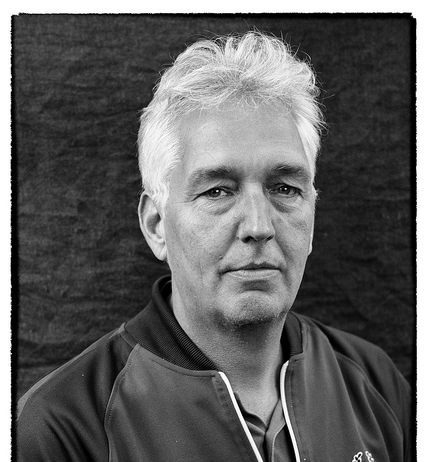 Erwin Blom
Erwin BlomErwin Blom: Dutch media maker, tech fanatic & music lover. Co-owner of Fast Moving Targets (media & innovation), co-founder of The Innovation Station, ‘different kind of tune vocalist’ of punkfunktechnotrash combo Eton Crop.
Just watched TIS.tv: PressPausePlay
According to Erwin Blom ‟Because it beautifully demonstrates the impact of digitization on media, music and movies”www.tis.tv
“Internet = Do It Yourself. Thanx to the internet we all can publish, we all can distribute, we all tell our stories. The impact of the digitization of media, music and movies has been enormous. Press Pause Play is a beautifully made documentary illustrating that new reality. Moby: “If you give a human a computer and broadband access, they are gonna make something interesting.”
Just watched TIS.tv: Us Now
According to Erwin Blom ‟Because social is one of the powers of the internet. Do It Together.”www.tis.tv
“Internet = Do It Together. Internet has cut out the middleman in almost every industry. Internet is the ultimate Do It Yourself medium. But it is a lot more. It is the medium that has made collaboration and working together across borders easy. And evolved from information to communication. Us Nowtells the story of the power of connecting people, the power of communities. It is a documentary from the days we were still talking about Web 2.0.”
Just watched TIS.tv: RIP : A Remix Manifesto
According to Erwin Blom ‟From the makers: This movie is about a war over ideas. The battleground is the internet. The…www.tis.tv
“Internet = remix culture. Creativity is using and reusing ideas. About being inspired by others, abouth building on the ideas of others. Remixing has been happening in other forms of art for ages, but plays a central role in the internet. RIP: A Remix Manifesto tells that story: “This movie is about a war over ideas. The battleground is the internet. The public domain must be protected.”
Just watched TIS.tv: Startup.com
According to Erwin Blom ‟This is what a bubble looks like!”www.tis.tv
“Internet = startup culture. The word startup is a word that is part of the internet. Internet is about a lot of things, but entrepreneurship is one of them. Internet is the story of young ambitious men and women wanting to conquer the world. In the early days everything seemed to go well. Money was flying around. Untill the bubble bursted in 2000.Startup.com is a brilliant documentary telling that story.”
Just watched TIS.tv: Good Copy Bad Copy (2007): A Documentary about Copyright and Culture
According to Erwin Blom ‟New world, new rights? The everlasting copyright debate is important!”www.tis.tv
“Internet = (the end of?) copyrights . Once something is digital it can be copied. And when it can be copied, it will be copied. Books, music, movies, on the internet everything is freely available. And when it’s easy to copy, it’s easy to re use, to sample and make something else with it. What is allowed? What isn’t? Copyrights have been an ongoing issue the past 25 years. Good Copy Bad Copy adresses that subject. “A balance needs to be struck between protecting the right of those who own intellectual property and the rights of future generations to create.”
Just watched TIS.tv: We Live in Public
According to Erwin Blom ‟Internet: the end of privacy or not?”www.tis.tv
“Internet = (end of?) privacy. On the internet everything we do leaves trails. On the internet companies and organisations know a lot about us. In the early days that hardly seemed an issue, but in the post-Snowden days and power of Facebook and Google, that’s a different story. We Live in Publicis a 2009 documentary by Ondi Timoner which profiles Internet pioneer Josh Harris. It has as its theme the loss of privacy in the internet age.”
Just watched TIS.tv: WikiRebels: The Documentary (Full)
According to Erwin Blom ‟The fight for freedom of information documented”www.tis.tv
“Internet = secrecy. Internet is as well transparancy as secrecy. Thanks to for example WikiLeaks where whistleblowers publish secret information, news leaks, and classified media from anonymous sources, we know a little about what governments and organisations know about us. WikiRebels The Documentary tells the story of the organisation that Assange started and that fights for freedom of information.”
The post Expert Selection: The Essence Of My Internet appeared first on Seats2meet.
January 2, 2018
College-Club is looking for a Research $ Events Intern
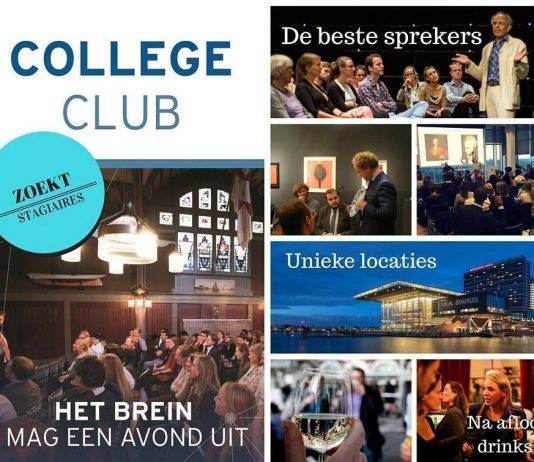
Maak kennis met een start-up in de praktijk!
Kijk jij liever naar Nieuwsuur dan naar RTL Boulevard? Ben je ondernemend, hou je van inhoud en voel je je aangetrokken tot de start-up wereld? Dan is deze stage jou op het lijf geschreven.
Wie zijn we?
College-Club organiseert boeiende avondcolleges in Amsterdam en New York City voor young professionals, met onderwerpen als ‘Google: trends en privacy’, ‘Kijken in het brein’, ‘Dynamics in World Politics’ en ‘Cyber security: de nieuwe wapenwedloop’. De colleges worden gegeven door de beste sprekers in hun veld en vinden plaats in o.a. EYE, het Compagnietheater, Van Gogh Museum en Het Concertgebouw. Ontdek de ontwikkelingen in de wereld van business en daarbuiten, leer meer over de laatste trends, werk mee aan de uitbreiding naar NYC, en vergroot je netwerk van young professionals. En uiteraard: drinks afterwards!

Wat ga je doen?
Vanuit ons unieke kantoor in hartje Amsterdam ben jij verantwoordelijk voor het bedenken en uitvoeren van nieuwe programmaconcepten. Hierbij hoort het scouten van de beste sprekers en geschikte locaties, waar je ook de contactpersoon voor bent. Je zorgt dat de colleges succesvol verlopen, enthousiasmeert de doelgroep met behulp van social media, en ontwikkelt de online marketingstrategie verder om de naamsbekendheid van College-Club in A’dam en NYC nog meer te vergroten. Kortom: een stage waar je jouw ondernemerschap, creativiteit en drive volledig in kwijt kunt en een flinke dosis verantwoordelijkheid krijgt!
Wat hebben wij jou te bieden?
Ervaring opdoen bij een groeiende start-up met één-op-één begeleiding van de oprichter;
Een stage waarin je alle ruimte krijgt om jouw kennis en skills in praktijk te brengen. Afhankelijk van jouw leerbehoefte kun je je met zeer afwisselende taken bezig houden. Hierdoor ga je straks de arbeidsmarkt op met een schat aan ervaring;
Gratis bijwonen van alle colleges;
Meewerken aan de uitbreiding naar NYC;
College-Club heeft een groot netwerk in het bedrijfsleven, de academische wereld en de start-up wereld. Hier maak jij straks onderdeel van uit;
Uiteraard krijg je een stagevergoeding (200 EUR bruto per maand op full-time basis).
Wie zoeken we?
Jij volgt een HBO of WO studie, bijvoorbeeld: bedrijfskunde, communicatiewetenschappen, Europese studies, eventmanagement, filosofie, geschiedenis, internationale betrekkingen, journalistiek, marketing, mediastudies of politicologie;
Je bent minimaal 3 tot 6 maanden beschikbaar, het liefst per februarien fulltime;
Je bent ondernemend, creatief, leergierig, positief ingesteld en goed op de hoogte van de actualiteit.
Geïnteresseerd?
Is dit profiel op je lijf geschreven? Reageer dan meteen door je CV en motivatie te sturen naar recruitment@college-club.nl. Wij zijn per begin februari op zoek! Wie weet maak jij binnenkort deel uit van ons enthousiaste team!
The post College-Club is looking for a Research $ Events Intern appeared first on Seats2meet.
Websites to keep an eye on in 2018

New times usually requires new fonts of information. Although classic channels can seem more trustworthy, they often lack the specific knowledge needed to truly keep up. For this reason, we listed some fonts that we love to go to get the latest trends.
Cryptocurrencies: Crypto Insider
The website was launched last year by several cryptocurrency and blockchain experts. Among them is Susanne Tarkowski Tempelhof, founder of Bitnation. The website posts daily. Midst its articles you can find everything related to the newest currencies, as political and economical events, new Startups and info about Blockchain that can impact your crypto wallet.
Go to cryptoinsider.com
New Stuff: Product Hunt
Product Hunt has been on my list for a few years already, but its combination of owners posting their own products, and the community being able to upvote them, makes it extra special. Because anyone can post their own products, you truly can find everything that is new there. And even better, because the community vote, you can really feel where the interest lies not for one person giving their opinion, but from several people. It makes it more accurate.
Go to producthunt.com
For Digital Nomads (and everything else involved in being one): Nomad List
By 2020 there will be one billion people working as a freelancer. We are very close to that mark, and lately freelancers discovered a new advantage to their job: they can do it from anywhere. The Nomad List is a paid website where people living this lifestyle can exchange experiences on how to get more clients, which are the best cities to live as a nomad and the necessary gear.
Go to Nomad List
Trending right now: Google Trends
It is more important than ever to know what is it that everyone else wants to know. Specially in a time where every company has a social media page and is looking for content to share all the time, and that content can be the divider between lots of traction and none. Twitter is a good font to know what is it that people are talking about. But I usually go to Google, as there you can see what people actually want to know and maybe are not being so loud about it. For an instance, the trending topic on twitter right now is all about the new year, but on Google people are searching about Liverpool F.C., the Dutch Trade Union Federation and about the YouTuber Logan Paul.
Another cool feature about Google Trends is that you can choose which specific topic you want to see the trends about, and you can see its behaviour on the last 24 hours.
Go to Google Trends
Be Entertained: Buzzfeed
As Buzzfeed might fail to transmit relevant information, the website succeeds in entertaining and bring interesting facts for a wide range of people. So if you ever feel bored and looking for something just to get your head out of things (which we all need sometimes) you can always count on Buzzfeed. Don’t know where to start there? I will recommend you the quizzes.
Go to Buzzfeed
If you are looking for amazing stories, you can always come back to the Seats2meet magazine, where we aim to inform and inspire by telling the stories of the incredible people in the ecosystem. Happy new year!
The post Websites to keep an eye on in 2018 appeared first on Seats2meet.
January 1, 2018
More About: Mobility

Exciting Times For The Future Of Mobility
From horse and carriage, diesel engine automobiles, electric cars, to Hyperloop’s transport system , the transport sector has changed a lot over the last 150 years. And so have our surroundings. To cope with the growing number of cars and increasing speed, we had to invest in roads and parking places, seatbelts and airbags and in speed bumps and traffic lights. What else will the future bring us?
In popular culture there are often references to the future of transport. Some of these are still years away from becoming reality (The Transport Machine, “Beam me up, Scotty”, from Star Trek), while others have already entered the market (hoover boards from Back to the Future).
Electric, solar, hydrogen and wind-powered cars
Investing in new kinds of transport does not only come from an entertainment point of view. Our generation is forced to come up with more sustainable transport solutions as we are running out of fossil fuels. Following are a few types of cars that are changing one of our most common ways of transportation:
Electric cars. Although electric cars were already popular in the 1880s, the advance of cheaper gasoline vehicles started a decline in electric cars. A short-lived revival came along with the 1980s oil crisis, but the electric car has only fully gained interested in 2008. By the late 2000’s due to advances in batteries and energy management, concerns about increasing oil prices, and the need to reduce the use of fossil fuels, more electric cars were manufactured. Many governments worldwide have since then established policies and economic incentives to stimulate the transition to electric cars. And critics for the limited distance an electric can drive can be silenced, since Quantino has proven it can go for 1000 kilometers on one tank.
Solar cars. While electric cars have made it as a consumer good, most solar cars are still only used for solar car races. Solar cars combine technology commonly used in aerospace, bicycle, alternative energy and automotive industries. They only run on power from the sun, which the photovoltaic cells (PV cells) on the solar array can convert into electricity. The current record for the fastest solar car goes to eVe, built by Australian students. The car travels with a speed of 107 kilometers per hour.
Hydrogen cars. Inside a hydrogen car, the chemical energy of hydrogen is converted into mechanical energy either by burning the hydrogen (internal combustion energy) or by reacting the hydrogen with oxygen (fuel cell). The byproduct of this process is water, so yes, it’s a very sustainable way of transport. However, hydrogen is not a natural product, it needs to be created from renewable sources which makes it an expensive process. One of the companies to keep an eye on is HyperSolar which is creating hydrogen from solar energy. Hydrogen is already used in a great deal of space shuttles and rockets.
Wind-powered cars. While wind-powered vehicles are primarily used in sailing, recently the automotive industry has started tests with wind-powered cars. Wikipedia mentions five successful vehicles: The Ventomobile, Spirit of Amsterdam (1 and 2), Mercedes-Benz Formula Zero, Greenbird (203 km/h!), Blackbird, which all use a wind turbine and light design to propel the car forward.
Connected vehicles
Connectivity is a major issue; no matter where you are, you need to be online to get the latest traffic report, be able to find a parking spot or reserve a place in the restaurant you’re heading to. Most of the cars are already able to play music, use smartphone apps, navigation, roadside assistance, voice commands, parking apps, engine controls and car diagnosis.
Not only cars can benefit from connectivity in terms of safety and convenience, but also other vehicles: truck platooning, smart bikes and smart scooters.
From smart to genius: autonomous vehicles
Many machines work without an operator, planes have an autopilot, Mars has its own rover and even your vacuum cleaner is doing its job by himself. But where are the self-driving cars? Should we build them ourselves, like this 26-year-old hacker did?
Autonomous vehicles would be able to detect their surroundings with radar, lidar, GPS, Odometry and computer vision, while advanced control systems identify navigation paths, obstacles and signage. Great for all road users: trucks, bikes, drone taxis, busses, trains and cars.
Some benefits include:
Avoiding traffic collisions caused by human errors
Everyone can use the car: blind, under age, intoxicated, etc.
More options for parking
More time for leisure activities or work while commuting
Some challenges include:
It will take time to replace all the non-autonomous cars
Implementation of legal framework, e.g. liability
Loss of driving-related jobs
Car computers might be compromised
But the most exciting project? Hyperloop!
Elon Musk’s new brainchild Hyperloop is a concept for a high-speed ground transport system that works with vacuum tubes. It would be able to send both cargo and people in a wagon capsule at the speed of 1200 km/h. The system would reduce the travel time between Los Angeles to San Francisco from 6 hours to 30 minutes. Hyperloop’s ultra-efficient form of transportation will be faster, safer, cheaper and 100% powered by clean energy.
Other videos worth watching:
Movpak: the electric skateboard that folds back into a backpack
The GeoOrbital Wheel: turn a regular bike into an ebike in 60 seconds
M55 Terminus: world’s fastest ebike
Straddling bus: concept bus driving high above regular traffic
Goodyear Eagle 360: replacing tires with spheres
Watch more videos on Mobility .
The post More About: Mobility appeared first on Seats2meet.



